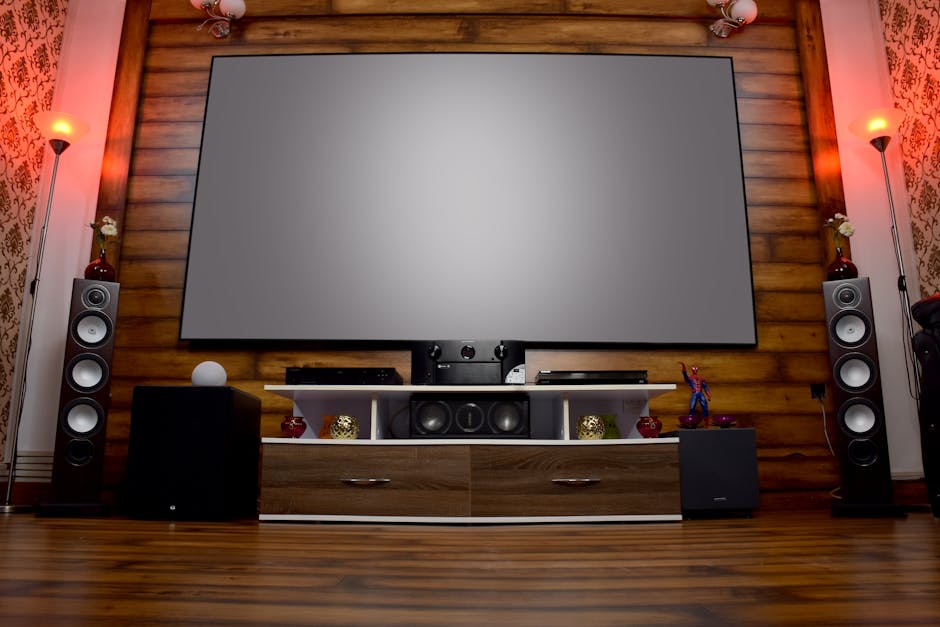Understanding Home Theater Systems: An Overview
Home theater systems transform your living room into a mini-cinema, offering an immersive movie experience right at home. At its core, a home theater setup involves a good quality display, a powerful sound system, and sometimes, additional gadgets like streaming devices or Blu-ray players to enhance your viewing pleasure. The goal? To bring that captivating cinema vibe into your space. Picture this: a crisp display that pulls you into the action, coupled with sound that moves around you, making every scene more lifelike. That’s what a home theater system does. Now, you might think setting this up is complex, but it’s pretty straightforward. You start with the TV or projector—this is your canvas. The bigger and clearer, the better. Then, add a sound system, which could be a soundbar for simplicity or a multi-speaker setup for the full surround sound experience. Remember, the essence of a home theater is about creating an environment that allows you to get lost in whatever you’re watching, making every movie night an event to look forward to.
Room Size and Acoustic Properties
Room size matters a lot when picking a home theater system. If you’ve got a big room, you’ll need a system that packs enough punch to fill the space without sounding weak or getting lost. On the flip side, a small room won’t need something super powerful, or it could end up sounding too loud and create echoes. Then, there’s the room’s acoustics to think about. Hard surfaces like windows and tiles bounce sound around, which can mess with the clarity of your movie’s dialogue or the depth of your music. Adding carpets or wall hangings can help absorb excess sound and reduce echo, making for a better listening experience. So, before you drop cash on that fancy system, take a good look at your room. It’ll save you from a headache later on.
Analysing Different Types of Home Theater Systems
When choosing a home theater system, know there are various types you can pick from. Two popular options are HTiBs (Home Theater in a Box) and Component Systems. HTiBs are the all-in-one solution, offering convenience as they come with everything you need to set up – think of it as a grab-and-go. They’re typically more affordable, with prices that won’t make your wallet cry, but you might compromise a bit on sound quality and customization. On the flip side, Component Systems allow you to handpick your speakers, receiver, and other equipment. This path is for those who love to tailor their experience and are willing to spend more to get that perfect sound. Ultimately, if you want easy and budget-friendly, go HTiB. If you’re all about crafting your dream sound and have the cash to back it, Component Systems are your best bet.
Visual Component Quality: Projection vs. LED vs. OLED
When setting up your home theater, the picture quality will make or break your experience. You’ve got main choices: projection, LED, and OLED. Let’s break them down. Projection systems give you that real cinema feel, offering huge screen sizes. However, they need a dark room to show their full potential. Plus, they can be a bit soft on the details compared to others. Next up, LED screens, which are basically your standard go-to TVs. They’re brighter than projectors, making them versatile for rooms with ambient light. They’re also more affordable but can struggle with true blacks, leading to less contrast in your movies. Then there’s OLED. These are the crème de la crème of picture quality, with perfect blacks and incredible contrast, thanks to individual pixels lighting up on their own. The catch? They’re pricier. So, think about what’s important for your watching habits and how much you’re willing to spend. Each has its perks and downsides, but getting the right one can transform your home theater into a personal cinema.
Sound Quality: Importance of Audio Components
When picking your home theater system, sound quality isn’t just another box to tick; it’s the soul of the experience. Imagine the difference between hearing a lion’s roar echo in your room as opposed to a simple meow. That’s the magic good audio components bring. You’re looking for a sound that pulls you in, making you forget the world outside. This means paying attention to speakers, subwoofers, and receivers. Good speakers deliver clear, rich sound that can make dialogues feel like whispers in your ear and explosions like a thunderstorm in your living room. Subwoofers add depth with bass that you don’t just hear but feel, while a solid receiver ensures all these components work in harmony. Remember, it’s not about loudness but clarity and immersion. Getting this right turns your movies, games, and music into experiences rather than just another Friday night.
Connectivity Options for Modern Home Theaters
When setting up a modern home theater, keep in mind the various connectivity options available. These options make it easier for your devices to talk to each other and enhance your viewing experience. First, HDMI is a must-have. It carries both audio and video signals and supports the latest formats for high-definition and 4K content. Then, there’s Bluetooth and Wi-Fi, perfect for streaming from smartphones or tablets without the mess of cables. Some systems also come with more traditional connections like optical and coaxial audio inputs, useful for connecting older devices or for pure audio setups. Remember, the more connectivity options you have, the more versatile your home theater will be. So, choose wisely to make sure all your devices can easily connect and bring your favorite shows and movies to life.
Budget Planning for Your Home Theater System
Setting a budget for your home theater system is crucial, and it’s where you should start. Think of it like this: you wouldn’t jump into building a house without knowing how much money you can spend, right? Same goes for your home theater. First off, figure out how much you’re willing to spend. Home theater systems can vary widely in cost, from a couple of hundred dollars to tens of thousands, depending on what you’re after. It’s essential to be realistic about what you can afford. Split your budget into categories; roughly calculate how much you can allocate for the visuals (like the TV or projector), the sound system (speakers, amplifiers), and any extras (streaming devices, comfortable seating, maybe even soundproofing). Remember, it’s easy to get carried away with fancy gadgets, but it’s not just about buying the most expensive items. It’s about making smart choices that fit your budget and meet your home theater dreams. Keep in mind, good planning now can save you from buyer’s remorse later.
Ease of Use and System Compatibility
When diving into home theater systems, you’ll quickly find that not all setups are user-friendly right out of the box. The last thing you want is to be tangled in a web of complex settings every time you want to watch a movie. Look for systems that are straightforward, featuring intuitive controls and simple remote designs that don’t require a manual to operate. Another critical aspect is system compatibility. Your home theater components need to play nice together. This means checking if your TV, speakers, and other devices like gaming consoles or Blu-ray players can easily connect without needing extra adapters or cables. In short, aim for a setup that promises a smooth, hassle-free experience, ensuring your movie night isn’t spent troubleshooting connections or decoding complex menus.
Customer Reviews and Brand Reputation
When hunting for the perfect home theater system, don’t skip checking out customer reviews and the brand’s reputation. Real talk: what others say can save you from a bad buy. Dive into websites, forums, or social media pages where folks share their honest feedback. Look for patterns. If many folks complain about the same issue, that’s a red flag. On the flip side, if there’s a lot of love for a specific model or brand, that’s a strong green light. Remember, a reputable brand doesn’t guarantee every product hits the mark, but it’s a good sign they care about quality. Your aim? Nab a system that brings the cinema feel to your pad, minus the drama.
Installation and Maintenance: What to Expect
Setting up your home theater is not just about buying gadgets and plugging them in. It’s about creating an experience. But here’s the thing, the ease of installation and the journey of maintaining your system play a gigantic role in that experience. First up, know this: you can do the setup yourself or hire professionals. Doing it yourself can save money, sure, but if the thought of handling wires makes you sweat, getting a pro isn’t a bad idea. They know their stuff, can hide wires cleverly, and ensure the best sound and picture quality.
Now, maintenance. It’s not a once-and-done deal. Dust off your speakers, check your wires for wear and tear, and update your system software regularly. Some systems are easier to maintain than others, so consider this before splurging. In a nutshell, think long-term. A system that’s a breeze to install but a nightmare to maintain (or vice versa) might not be worth your time or money. Choose wisely, and you’ll have a killer home theater experience with less hassle.



